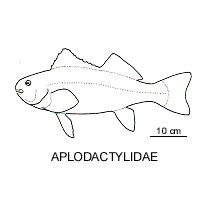- Classification
- ACTINOPTERYGII
- PERCIFORMES
- APLODACTYLIDAE
-
Fish Classification
-
Class
ACTINOPTERYGII Ray-finned fishes -
Order
PERCIFORMES Perches and allies -
Family
APLODACTYLIDAE Marblefishes -
Genera
Aplodactylus(4)
Family APLODACTYLIDAE
Body moderately long, robust, compressed with a small rounded head, a small mouth slightly under the short snout, a thick upper lip, a long-based, low, deeply notched dorsal fin, large pectoral fins with the lower rays free and thickened, pelvic fins inserted well behind pectoral-fin base.
Russell (1987) discussed Australian species and subsequently revised the family, recognising one genus and five species (Russell 2000). Four aplodactylid species occur in Australian waters. Maximum length reached is 60 cm.
More Info
|
Family Taxonomy |
A small family with a single genus and 5 species found in temperate Southern Hemisphere waters of the Pacific Ocean from Australia to South America. Burridge (2000) presented a molecular phylogeny of the group, suggesting an Australian-New Zealand origin, with a much later spread to South America. |
|
Family Distribution |
Temperate Southern Hemisphere waters of the Pacific Ocean from Australia to South America - around rocky reefs. |
|
Family Description |
Meristic features: Dorsal fin XIV-XXIII, 16-21; Anal fin III, 6-10; Pelvic fin I, 5; Lateral line scales more than 75. |
|
Author |
Dianne J. Bray |
References
Burridge, C.P. 2000. Molecular phylogeny of the Aplodactylidae (Perciformes: Cirrhitoidea), a group of Southern Hemisphere marine fishes. Journal of Natural History 34: 2173-2185.
Burridge, C.P. 2000. Biogeographic history of cirrhitoids (Perciformes: Cirrhitoidea) with east-west allopatric distributions across southern Australia, based on molecular data. Global Ecology and Biogeography 9: 517-525.
Russell, B.C. 1987. New Australian fishes. Part 20. A new species of Aplodactylus (Aplodactylidae). Memoirs of Museum Victoria 48(1): 85-87 fig. 1
Russell, B.C. 2000. Review of the southern temperate fish family Aplodactylidae (Pisces: Perciformes). Journal of Natural History 34: 2157-2171





































